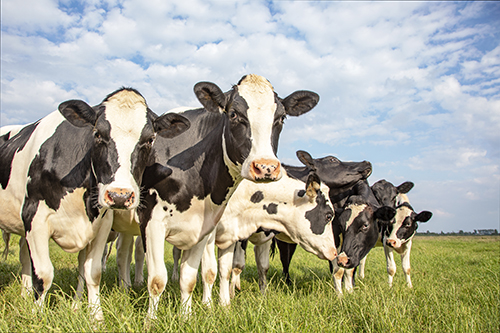Forage for Dry Cows
Jun 20, 2022

We recognize that the primary goals of the dry period are to regenerate mammary tissue, replenish body reserves (both soft tissue and mineral), and provide some rest for the cow before the onset of the next lactation. It is especially critical that the dry cow feeding program be designed to meet her unique nutritional requirements to help prevent undue stress and other metabolic diseases and improve early lactation performance. Since dry cow rations generally contain a predominance of forage (70 to 85% of the total ration dry matter), the success of the dry cow program is largely dependent upon forage quality and the specific nutrients forage is providing. The following is a listing of general characteristics for optimal dry cow forage:
Differing forages provide both advantages and disadvantages for dry cows. Always have forage tested to ensure the ration can be balanced properly. Common dry cow forages are listed below.
Grass Hay
Grass is virtually essential for dry cow rations. Grass hay provides fiber and bulk, has a lower energy concentration, and is generally lower in Calcium (Ca) and Phosphorus (P). It is vital to have grass hay analyzed as the potential for high K level is common with Tennessee’s fescue-based grasses. Depending on mineral content, it is certainly acceptable to offer good-quality grass hay from 30% to as much as 90% of overall ration dry matter.
Corn Silage
Corn silage is very common in our area and provides good forage for dry cows as it is very palatable and typically has a favorable mineral profile (low Ca, P, K). Corn silage should be limited to approximately 25 lbs. per head per day as over-feeding provides excess energy and reduces rumen fill.
Wheat Silage
Dry cows readily consume good-quality wheat silage. It does, however, contain a less than favorable mineral profile in that K is typically high. While wheat silage generally has more fiber than corn silage, it should be limited to 25% or less of ration dry matter.
Wheat Straw
Straw has gained acceptance for dry cows due to its lower energy, decent mineral profile, and high fiber content. Straw combined with corn silage is an effective dry cow forage program. Straw must be processed to prevent potential sorting. Best results are obtained when the straw is limited to 20% of overall ration dry matter.
For any questions regarding animal nutrition, reach out to your local Co-op livestock specialist. Find your nearest Co-op here. For more content like this, check out the latest issue of The Cooperator.
- Palatable
- Mold-free
- Modest energy/starch content
- Low potassium (K) content
- High bulk/rumen fill potential
Differing forages provide both advantages and disadvantages for dry cows. Always have forage tested to ensure the ration can be balanced properly. Common dry cow forages are listed below.
Grass Hay
Grass is virtually essential for dry cow rations. Grass hay provides fiber and bulk, has a lower energy concentration, and is generally lower in Calcium (Ca) and Phosphorus (P). It is vital to have grass hay analyzed as the potential for high K level is common with Tennessee’s fescue-based grasses. Depending on mineral content, it is certainly acceptable to offer good-quality grass hay from 30% to as much as 90% of overall ration dry matter.
Corn Silage
Corn silage is very common in our area and provides good forage for dry cows as it is very palatable and typically has a favorable mineral profile (low Ca, P, K). Corn silage should be limited to approximately 25 lbs. per head per day as over-feeding provides excess energy and reduces rumen fill.
Wheat Silage
Dry cows readily consume good-quality wheat silage. It does, however, contain a less than favorable mineral profile in that K is typically high. While wheat silage generally has more fiber than corn silage, it should be limited to 25% or less of ration dry matter.
Wheat Straw
Straw has gained acceptance for dry cows due to its lower energy, decent mineral profile, and high fiber content. Straw combined with corn silage is an effective dry cow forage program. Straw must be processed to prevent potential sorting. Best results are obtained when the straw is limited to 20% of overall ration dry matter.
For any questions regarding animal nutrition, reach out to your local Co-op livestock specialist. Find your nearest Co-op here. For more content like this, check out the latest issue of The Cooperator.